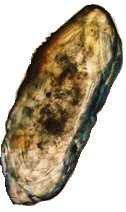
August Editorial
Zircons hold the answers to early rock formation

August Editorial
Zircons hold the answers to early rock formation
|
|
Zircons, the oldest known materials on Earth, are a very useful dating tool. They form at temperatures between 1,112 degrees and 1,652 degrees Fahrenheit (600 -900 degrees Celsius) and, once crystallized, a zircon's chemical make-up and structure don't change, making it easy to determine its age through a process similar to carbon dating. Detrital zircons ('detrial' refers to the detrius of loose grains of minerals or rocks that have been eroded from other rocks or earth materials ) which are found in Jack Hills, Western Australia can be dated as far back as 4.4 billion years ago and are the oldest identified fragments of the Earth's crust. They are therefore unique in preserving information about the earliest events that happened on Earth. Four and a half billion years ago the Earth was less than 150 million years old. The tiny grains of detrius containing Zircons have been used to date the Earth's oldest diamonds (See September 2007 editorial on this site), as well as to show that rocky continents and liquid water formed on the Earth much earlier than previously thought (about 4.2 billion years ago - accordingto John Valley, of the University of Wisconsin-Madison). A new study has just been published in the Journal Earth and Planetary Science Letters (Available online 10 June 2008) led by Takayuki Ushikubo, (of which John Valley is the co-author). This provides evidence that solid rock formations were present on the surface of Earth at least 4.3 billion years ago, but these were completely destroyed by heavy weathering due to the acrid climate of the time. If this is correct it would provide the answer to a long standing question in geology: why no rock samples have ever been found dating back to the first 500 million years after the Earth formed. Previous theories had postulated that the rocks were destroyed by continuous bombardment by meteorites during the Earth's early years. Others suggested that the early Earth was a red-hot sea of magma in which rocks could not form. Although heavy weathering earlier than 4 billion years ago was also there among the hypotheses, there was no direct proof for it. Takayuki Ushikubo and his colleagues analysed the ratios of the element lithium (Li) in zircons from the Jack Hills using an ion microprobe. A microprobe is an instrument that applies a stable and well-focused beam of charged particles (electrons or ions) to a sample. On previous occasions scientists have successfully used this beam to determine the elemental composition of solid materials such as minerals, glasses or metals. Using the ion probe, the group from the University of Wisconsin-Madison was able to compare the lithium composition of zircons from the continental crust and primitive rocks similar to the Earth's mantle. They found that Li concentration in detrital zircons from the Jack Hills was typically 10 to 60 ppm. Which means that when compared with the concentration of Li in zircons crystallized from mantle-derived magmas and in mantle-derived zircon megacrysts the concentration was on average over 10,000 times higher. However, the lithium concentration was comparable to that found in three continental parent rocks: granites, Li-rich pegmatites, and migmatites in pelitic metasediment. What that suggests is that these zircons were not part of the mantle magma but rather formed from the continental crust. Next the group fractionated Li isotope ratios. Again they found that the ratios were comparable with continental crust but were about 5 times higher than those in primitive ocean floor basalts. Taking all the evidence together, the researchers found evidence that the young planet already had the beginnings of continents, relatively cool temperatures and liquid water by the time the Australian zircons were formed. Their results strongly suggest that there were rocks on the surface of the Earth as early as 4.3 billion years ago, but they were completely destroyed due to weathering. At that time the Earth's atmosphere contained extremely high levels of CO2. It is thought that the levels of carbon dioxide were as much as 10,000 times higher than today. Carbon dioxide in the atmosphere can combine with water to form carbonic acid, which falls as acid rain. The high levels of acid rain and intense greenhouse effect would have dissolved any rocks on the Earth's surface completely. Other scientists who contributed to this research include Aaron Cavosie of the University of Puerto Rico, Simon Wilde of the Curtin University of Technology in Australia and Roberta Rudnick of the University of Maryland. |
| _______________________________ | ||||
| Home | | | Shopping | | | Database |
© Biscuit Software 2004-2015
All rights reserved